
Bismillaher Rahmanir Rahim.
Assalamu Alaikum Wa Rahmatullahi Wa Barakatuhu
Dear Companions Today I want to share with you some words about the evils of killing foetuses.Welcom to this post and congratulations to all
The round potato, a common variety of the potato plant (Solanum tuberosum), is a staple in many diets across the globe. Potatoes are versatile, nutritious, and relatively easy to cultivate. Whether grown on a large farm or in a small backyard garden, round potatoes can thrive in various climates and soil types. This guide provides an overview of round potato cultivation, nutritional value, and the best methods for preserving potatoes.
- Round Potato Cultivation Method
1.1. Soil Preparation
Potatoes thrive in well-drained, loose, and slightly acidic soil with a pH between 5.0 and 6.0. Before planting, the soil should be prepared by tilling to a depth of at least 12 inches to break up clumps and ensure proper aeration. Adding organic matter, such as compost or well-rotted manure, can improve soil fertility and structure. Potatoes require nutrient-rich soil, especially in phosphorus and potassium.
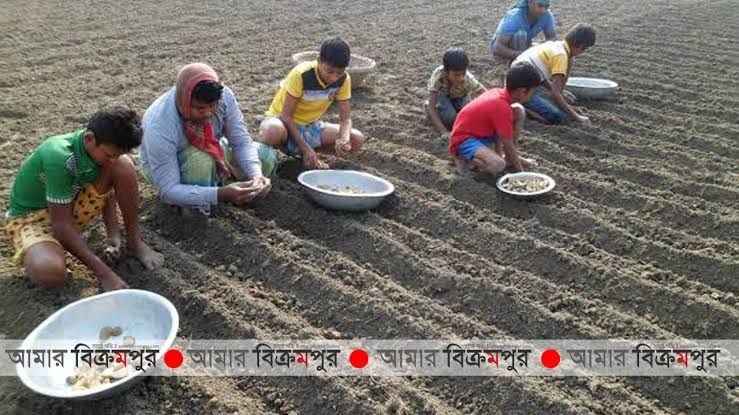
source
1.2. Seed Potatoes Selection
Seed potatoes, small tubers or pieces of tubers with at least one or two “eyes” (sprouts), are the starting point for potato cultivation. It's crucial to choose certified, disease-free seed potatoes to avoid introducing pathogens into the soil. Round potatoes come in different varieties, such as Yukon Gold or Maris Piper, and selecting the right variety for your climate and intended use is important.
1.3. Planting
Potatoes should be planted in early spring when the soil temperature reaches around 50°F (10°C). They are typically grown in rows. Each seed potato or piece should be planted 3-4 inches deep, with the “eye” facing upward. Space the plants 12-15 inches apart, with rows about 30 inches apart, allowing the plants room to grow and spread. As the plants grow, mound soil around the stems to protect developing tubers from sunlight (which can turn them green and toxic).
1.4. Irrigation and Maintenance
Potatoes require consistent moisture, particularly during the tuber formation stage. Watering should be done deeply but infrequently to avoid waterlogging, which can cause tuber rot. Drip irrigation systems can be highly effective in maintaining soil moisture levels. It’s essential to keep the field weed-free, especially in the early stages of growth. Mulching around the plants can help conserve soil moisture and suppress weeds.
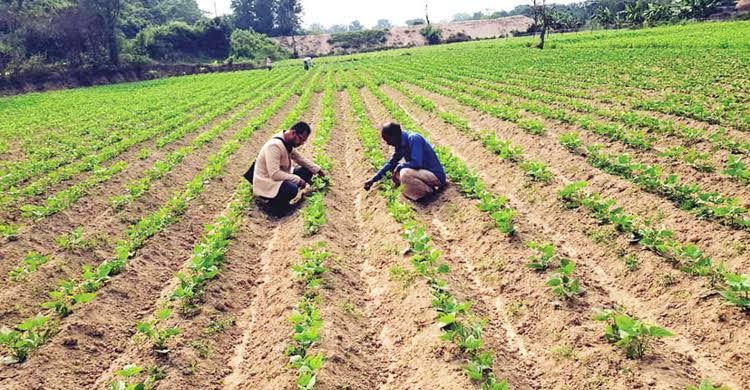
source
1.5. Fertilization
Potatoes are heavy feeders, particularly in nitrogen during the early stages of growth. Fertilizing with a balanced fertilizer (10-10-10 or similar) at planting time will help provide the nutrients needed for healthy growth. Additional applications of potassium and phosphorus, either through organic sources like bone meal or commercial fertilizers, will promote healthy tuber development.
1.6. Pest and Disease Management
Several pests and diseases can affect potato crops. Common pests include Colorado potato beetles, aphids, and wireworms, while diseases like blight (late and early) and potato scab are common. Rotating crops, using resistant varieties, and ensuring proper plant spacing can help reduce the risk of disease. Organic growers often use natural predators or insecticidal soaps to control pests, while conventional farmers may use chemical pesticides and fungicides.
1.7. Harvesting
Round potatoes are typically ready to harvest 80-100 days after planting. Harvesting is done once the plant’s foliage has turned yellow and died back. Gently dig around the plants with a fork or spade to avoid damaging the tubers. After harvesting, potatoes should be left to dry in the field or a shaded area for several hours to toughen their skin.
- Nutritional Value of Round Potatoes
Potatoes are often regarded as a starchy food, but they provide much more than just carbohydrates. They are rich in essential nutrients that contribute to a balanced diet.
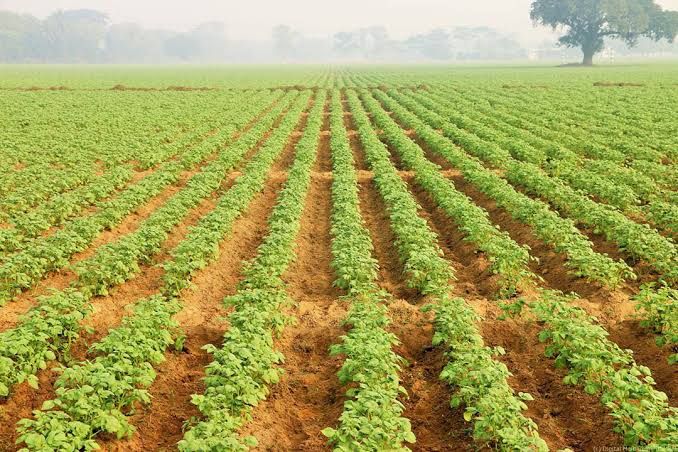
source
2.1. Macronutrients
Carbohydrates: Potatoes are an excellent source of complex carbohydrates, providing energy for daily activities. One medium-sized potato contains approximately 37 grams of carbohydrates.
Protein: While not a high-protein food, potatoes contain about 4 grams of protein per medium potato, contributing to daily protein intake.
Fats: Potatoes are naturally fat-free, making them a low-calorie option for those looking to reduce fat consumption.
2.2. Vitamins and Minerals
Vitamin C: Potatoes are surprisingly high in vitamin C, with one medium potato providing about 30% of the daily recommended intake. Vitamin C is essential for immune function, skin health, and collagen production.
Potassium: Potatoes are an excellent source of potassium, a mineral that helps regulate blood pressure and balance fluids in the body. A medium potato contains around 620 milligrams of potassium.
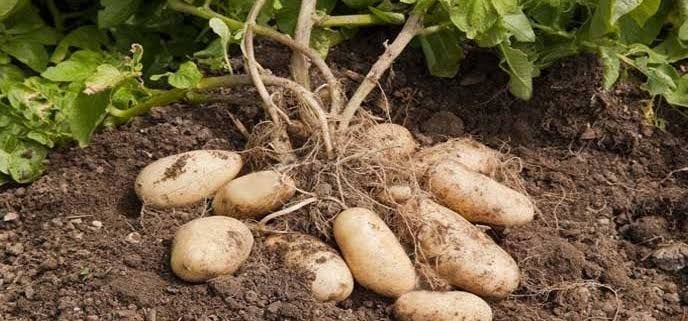
source
Vitamin B6: This vitamin is crucial for brain development and function and helps the body convert food into energy.
Iron and Magnesium: Potatoes provide small amounts of iron and magnesium, supporting oxygen transport and muscle function.
2.3. Fiber
A medium potato with the skin provides about 2 grams of dietary fiber, which aids in digestion and helps maintain a healthy digestive tract. The fiber content is mostly in the skin, so consuming unpeeled potatoes is beneficial.
- Round Potato Preservation Method
Proper storage is key to maximizing the shelf life of potatoes while maintaining their nutritional value and preventing spoilage.
3.1. Curing Potatoes
Before long-term storage, potatoes should be cured to allow their skins to toughen and any minor cuts or bruises to heal. After harvesting, potatoes should be placed in a cool, dark, and well-ventilated area for 1-2 weeks at temperatures around 50-60°F (10-15°C). Curing helps prevent spoilage during storage.
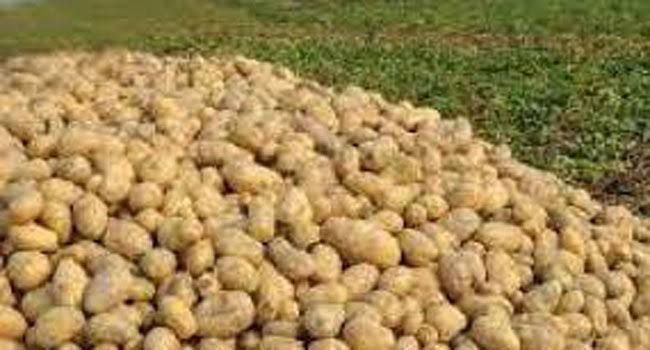
source
3.2. Ideal Storage Conditions
Potatoes should be stored in a dark, cool, and well-ventilated space to prevent sprouting and spoilage. A temperature range of 45-50°F (7-10°C) is ideal for long-term storage. Avoid storing potatoes in the refrigerator, as cold temperatures can cause the starch to convert to sugar, altering the taste and texture.
3.3. Avoiding Light Exposure
Exposure to light can cause potatoes to turn green and develop solanine, a toxin that can be harmful if consumed in large amounts. Always store potatoes in a dark place, and if any green spots appear, they should be cut away before cooking.
3.4. Humidity Control
While potatoes need moisture to prevent shriveling, excess humidity can lead to rot. Maintaining a relative humidity of 85-90% helps balance moisture levels without promoting spoilage. Potatoes can be stored in burlap sacks or mesh bags, which allow air circulation while protecting them from light.
3.5. Periodic Checking
During storage, potatoes should be periodically checked for signs of sprouting or spoilage. Any potatoes that begin to sprout or show signs of rot should be removed to prevent them from affecting the rest of the batch.
3.6. Freezing and Other Preservation Methods
While freezing raw potatoes is not recommended, cooked potatoes can be frozen for later use. Blanching the potatoes before freezing helps preserve their texture. Additionally, potatoes can be preserved by dehydrating or canning, though these methods may alter their texture and flavor.
The round potato is a highly nutritious and versatile crop, ideal for home gardeners and large-scale farmers alike. Proper soil preparation, pest management, and harvesting techniques are essential for a healthy yield. The nutritional profile of potatoes, including their carbohydrate content, fiber, vitamins, and minerals, makes them a valuable part of any diet. By following the recommended preservation methods, potatoes can be stored for extended periods, ensuring a constant supply throughout the year. With careful attention to detail, round potato cultivation and preservation can be both rewarding and sustainable.
Upvoted. Thank You for sending some of your rewards to @null. Get more BLURT:
@ mariuszkarowski/how-to-get-automatic-upvote-from-my-accounts@ blurtbooster/blurt-booster-introduction-rules-and-guidelines-1699999662965@ nalexadre/blurt-nexus-creating-an-affiliate-account-1700008765859@ kryptodenno - win BLURT POWER delegationNote: This bot will not vote on AI-generated content
Telegram and Whatsapp